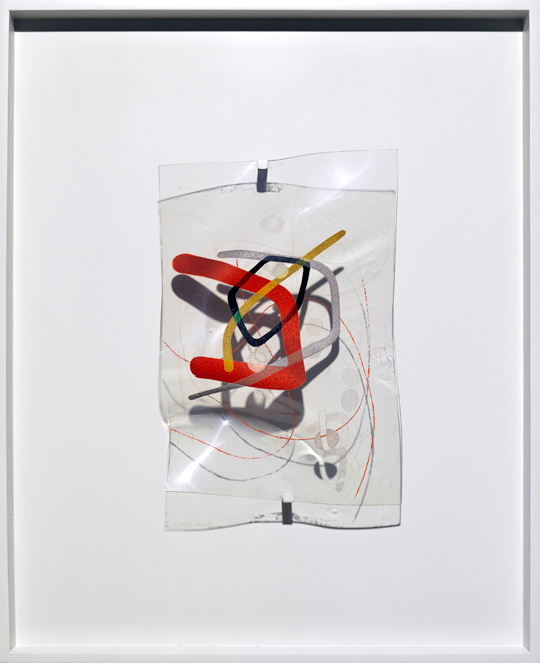 Photogram, 1926
Photogram, 1926
Gelatin silver photogram
Los Angeles County Museum of Art,
Ralph M Parsons Fund
Photo © Museum Associates/LACMA
Moholy-Nagy: Future Present
Solomon R Guggenheim Museum
NYC | USA
27 May > September 2016
 Construction AL6 (Konstruktion AL6), 1933 > 34
Construction AL6 (Konstruktion AL6), 1933 > 34
Oil and incised lines on aluminium
IVAM, Institut Valencià d’Art Modern, Generalitat
We were taking a look at the Bauhaus and specifically the work of MOHOLY-NAGY, whose surname our enthusiastic art teacher spelled out for us in large capital letters on the chalkboard – I know now he didn’t know how to pronounce it properly. He’d also dispensed with his subject’s first name, László, which he was probably on similar uncertain terms with. This was in the late 1960s when detailed information on 20th century avant garde art and artists was relatively sparse, and a few years prior to the last major retrospective of László Moholy-Nagy’s (1895 > 1946) work in the United States.
The Solomon R Guggenheim Museum, describing their forthcoming Moholy-Nagy: Future Present retrospective, which includes some 300 works by the Hungarian painter, photographer, typographer, film-maker, theorist, Bauhaus professor (1923 > 1928), director of the short-lived New Bauhaus in Chicago, and founder of Chicago’s Institute of Design, gathered from a wide range of international sources, explains that despite his prominence during his lifetime, few previous exhibitions have conveyed the experimental nature of Moholy-Nagy’s work – his enthusiasm for industrial materials, his radical innovations with movement and light. This may be so in the US, but in Germany the Schirn Kunsthalle Frankfurt showed some of the same experimental pieces, albeit a smaller selection, in 2009.
 Room of the Present (Raum der Gegenwart),
Room of the Present (Raum der Gegenwart),
Constructed in 2009 from plans
and other documentation dated 1930
Mixed media
Installation view: Play Van Abbe – Part 2:
Time Machines, Van Abbemuseum, Eindhoven,
April 10 > September 12, 2010
Photo Peter Cox, courtesy Art Resource, New York
 B‑10 Space Modulator, 1942
B‑10 Space Modulator, 1942
Oil and incised lines on perspex in original frame
Solomon R Guggenheim Museum, New York
 Dual Form with Chromium Rods, 1946
Dual Form with Chromium Rods, 1946
Perspex and chrome-plated brass
Solomon R Guggenheim Museum, New York
Photo Kristopher McKay
© Solomon R Guggenheim Foundation, New York
Exhibitions such as these are important and provide vital opportunities for seeing carefully-curated and well-presented original works in the round and at full scale, and each brings something new that extends our understanding of a particular artist’s oeuvre. Related lectures and films are often presented and extensive catalogues produced that serve to extend the event itself and bring in additional revenue for the venue. It’s also true to say that, since the 1960s, and especially since open-access historical archives have been made available online by many institutions, in recent decades research facilities available to the general public (as well as teachers) have improved beyond measure. As a prelude to visiting a show, or as a post-visit extension of it, whereby we build on our experiences and impressions, each of us – with a little effort – is now in a position to examine complex artists such as Moholy-Nagy – everyone tends only to use his surname and has learn how to pronounce it correctly via the internet – in great detail and with relative ease.
The Moholy-Nagy Foundation was set up in 2003, and has a comprehensive online image database featuring work in every medium he experimented in, as well as dependable biographical details and a photo library. There’s more, too, presented from other viewpoints at Bauhaus Online and elsewhere on the sites of galleries and museums where exhibitions of his have been presented.
By viewing exhibitions, reading publications and looking at website information about the artists who worked before, at the same time, and after the period in which Moholy-Nagy was active, it’s possible to see what influenced him, how he related to and influenced others, and to place him in an accurate and broad historical perspective. For instance, perhaps it was coincidental, but although the Calder Foundation site claims that Alexander Calder, following a visit to Piet Mondrian’s studio made his first wholly abstract compositions and invented the kinetic sculpture in 1930, Moholy-Nagy’s kinetic sculpture Light-Space-Modulator, designed in 1922, was exhibited for the first time in Paris, also in 1930. And, while MoMA’s site explains that Man Ray claimed to have invented the photogram (christening it the Rayogram) in Paris in 1921 – although the practice had existed since the earliest days of photography – less than a year later, Moholy-Nagy was making his own photograms. Argentine-born Italian artist Lucio Fontana founded the Spazialismo (spatialism) movement in 1947, stating in its manifesto that art should embrace science and technology, but it’s not difficult for us to discover elsewhere that this principle, had been the cornerstone of Moholy-Nagy’s practice since he drew his first inspiration from the Russian constructivists in 1918.
In the 21st century exhibitions such as Moholy-Nagy: Future Present at the Solomon R Guggenheim Museum, once viewed as self-contained events, have come to represent points of both arrival and departure for those wishing to educate themselves about art.
All artworks created by László Moholy-Nagy
© 2016 Hattula Moholy-Nagy/VG Bild-Kunst,
Bonn/Artists Rights Society (ARS), New York
All images courtesy © Solomon R Guggenheim Foundation, New York
Tell us what you think
The Blog is about art, architecture, books, design and gardens, and anything else that currently interests us that we think might interest you.
The Blog’s publishers insist that all images supplied for publication in our posts are cleared for that use before being sent to us. Whether pictures are sent to us as email attachments or made available as downloadable files, any responsibility for fees that may, under any circumstances whatsoever, fall due, must be borne by the source supplier




















